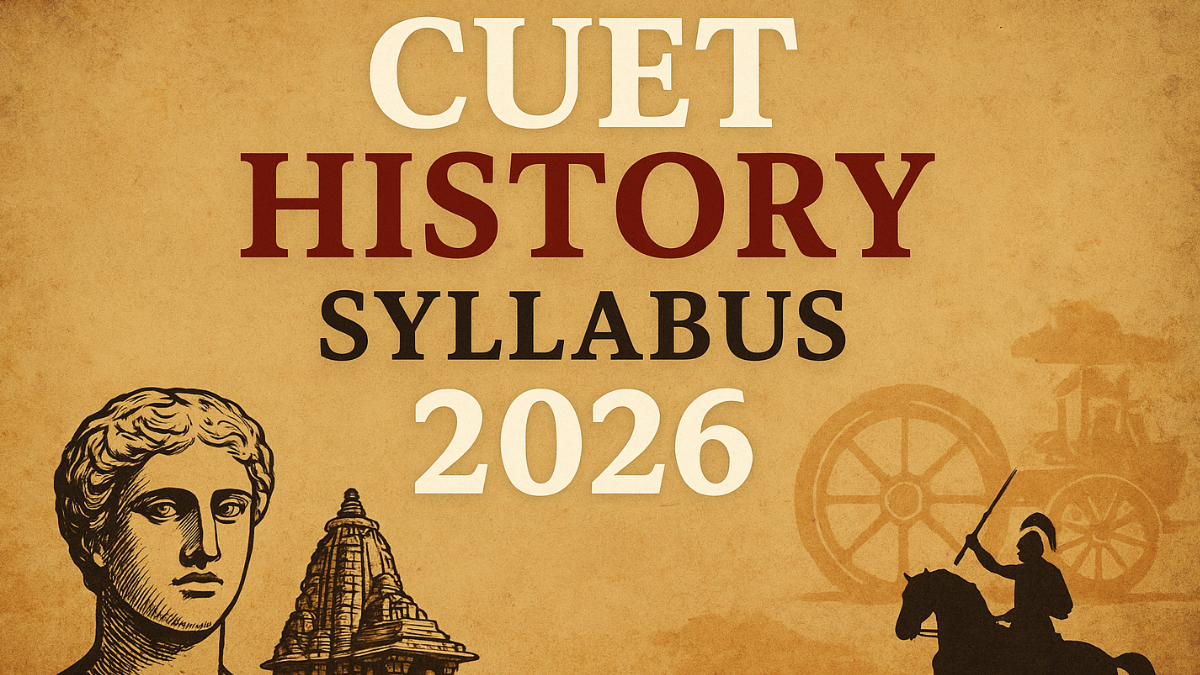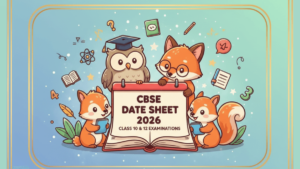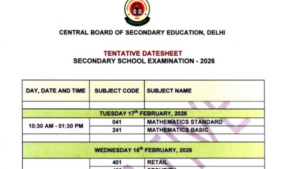The National Testing Agency issued the CUET History Syllabus 2026 on its official website. Based on the NCERT Class 12 curriculum, the official CUET 2026 history syllabus covers topics like colonialism and the Constitution’s development, Buddhism history, the Bhakti-Sufi tradition, Harappan archaeology, and the Mahabharata.
Understanding the CUET UG History Syllabus in detail is the pillar for candidates who want to pursue higher education in the History domain.Applicants must thoroughly review the CUET History Syllabus before beginning the complete phase of preparation. Candidates can also get the CUET History Syllabus PDF from this page.
CUET History Syllabus 2026
The Common University Entrance Test (CUET) is held for students who are pursuing undergraduate admission to Central Universities. There are three sections in the CUET Exam Pattern, Sections 1A and 1B cover General and Special Languages, Section II covers 23 Domain-specific Subjects, and Section III covers the General Test.
The CUET Section-II comprises examinations on all domain-specific subjects. History is covered in Section II. To get enrolled in the BA History at the Top central universities, you must plan your preparation in line with the official history syllabus and paper pattern.
CUET UG History Exam Pattern Overview
History question papers have 50 questions and all are mandatory. The CUET History exam is conducted in computer based test for a time duration of 60 minutes. The table below contains important information about the CUET UG History Exam Syllabus and its exam pattern.
| CUET History Exam Syllabus Overview | |
| Exam conducting body | National Testing Agency |
| Examination Name | Common Universities Entrance Test (CUET UG) |
| Medium of Examination | 13 Languages (English, Kannada, Hindi, Punjabi, Marathi, Tamil, Urdu, Malayalam Odia, Assamese Telugu, Bengali and Gujarati ) |
| Examination Mode | Computer-based Test (CBT) |
| Time allotted for History Exam | 60 minutes |
| Total number of questions in the History section | 50 questions |
| Total History Questions to be Answered | All questions are compulsory |
| Total Marks in History Section | 250 Marks |
| Marking Scheme | Marks per correct answer: +5 Marks per the wrong answer: -1 Marks per unanswered questions: 0 |
Download CUET Previous Year Question Paper PDF
Unit-Wise CUET History Syllabus 2026
History Syllabus is comparatively lengthy due to its a variety of themes. Candidates who want to purses higher studies in the history domain must have a good understanding of the CUET History Syllabus. The CUET History Syllabus 2026 consists of a total of 15 units. As follows
|
CUET History Syllabus & Units |
|
| 1 | The Story of the First Cities Harappan Archaeology |
| 2 | Political and Economic History: How Inscriptions tell a story |
| 3 | Social Histories using the Mahabharata |
| 4 | A History of Buddhism: Sanchi Stupa |
| 5 | Medieval society through Travellers’ Accounts |
| 6 | Religious Histories: The Bhakti-Sufi Tradition |
| 7 | New Architecture: Hampi |
| 8 | Agrarian Relations: The Ain-i- Akbari |
| 9 | The Mughal Court: Reconstructing Histories through Chronicles |
| 10 | Colonialism and Rural Society: Evidence from Official Reports |
| 11 | Representations of 1857 |
| 12 | Colonialism and Indian Towns: Town Plans and Municipal Reports |
| 13 | Mahatma Gandhi through Contemporary Eyes |
| 14 | Partition through Oral Sources |
| 15 |
The Making of the Constitution
|
History Syllabus Unit-wise
Here you can get the overview of the complete History syllabus of CUET UG 2026 exam.
| CUET UG History Exam Syllabus | |||||
| Themes in Indian History Part – I | Themes in Indian History Part – II | Themes in Indian History Part – III | |||
| Theme I | The Story of the First Cities: Harappan Archeology | Theme V | Agrarian Relation: The Ain-i-Akbari | Theme IX |
Colonialism and Rural Society: Evidence from Official Reports
|
| Theme II | Political and Economic History: How Inscriptions tell a story | Theme VI | New Architecture Hampi | Theme X |
Representation of 1857
|
| Theme III | Social Histories: Using the Mahabharata | Theme VII | Religious History: The Bhakti-Sufi Tradition | Theme XI |
Mahatma Gandhi through Contemporary Eyes
|
| Theme IV |
A History of Buddhism: Sanchi Stupa
|
Theme VIII | Medieval Society through Traveller’s Accounts | Theme XII |
The making of the Constitution
|
CUET History Syllabus, Unit I
Unit I: The Story of the First Cities Harappan Archaeology
Broad overview: Early urban centres.
Story of discovery: Harappan civilization.
Excerpt: Archaeological report on a major site. Discussion: how it has been utilized by archaeologists/ historians.
CUET History Syllabus, Unit II
Unit II: Political and Economic History: How Inscriptions tell a story
Broad overview: Political and economic history from the Mauryan to the Gupta period.
Story of discovery: Inscriptions and the decipherment of the script. Shiftsin the understanding of political and economic history.
Excerpt: Asokan inscription and Gupta period land grant.
Discussion: Interpretation of inscriptions by historians.
CUET History Syllabus, Unit III
Unit III: Social Histories using the Mahabharata
Broad overview: Issues in social history, including caste,class, kinship and gender.
Story of discovery: Transmission and publications of the Mahabharata.
Excerpt: From the Mahabharata, illustrating how it has been used by historians.
CUET Previous Year Question Paper
CUET History Syllabus, Unit IV
Unit IV: A History of Buddhism: Sanchi Stupa
Broad overview:
(a) A brief review of religious histories of Vedic religion, Jainism, Vaisnavism, Saivism.
(b) Focus on Buddhism.
Story of discovery: Sanchi stupa.
Excerpt: Reproduction of sculptures from Sanchi. Discussion: Ways in which sculpture has been interpreted by historians, other sources for reconstructing thehistory of Buddhism.
CUET History Syllabus, Unit V
Unit V: Medieval society through Travellers’ Accounts
Broad Overview: Outline of social and cultural life as they appear in travellers’ accounts.
Story of their writings: A discussion of where they travelled, why they travelled, what they wrote, and For whom they wrote.
Excerpts: from Alberuni, Ibn Batuta, Bernier.
Discussion: What these travel accounts can tell us and how they have been interpreted by historians.
CUET History Syllabus, Unit VI
Unit VI: Religious Histories: The Bhakti-Sufi Tradition
Broad Overview:
(a) Outline of religious developments during this period.
(b) Ideas and practices of the Bhakti-Sufi saints.
Story of Transmission: How Bhakti-Sufi compositions have been preserved.
Excerpt: Extracts from selected Bhakti Sufi works.
Discussion: Ways in which these have been interpreted by historians
CUET History Syllabus, Unit VII
Unit VII: New Architecture: Hampi
Broad Overview:
(a)Outline of new buildings during Vijayanagar period — temples, forts, irrigation facilities.
(b)Relationship between architecture and the political system.
Story of Discovery: Account of how Hampi was found.
Excerpt: Visuals of buildings at Hampi.
Discussion: Ways in which historians have analysed and interpreted these structures.
CUET History Syllabus, Unit VIII
Unit VIII: Agrarian Relations :The Ain-i- Akbari
Broad overview:
(a) Structure of agrarian relations in the 16th and 17th centuries.
(b) Patterns of change over the period.
Story of Discovery: Account of the compilation and translation of Ain-i-Akbari.
Excerpt: From the Ain-i-Akbari
Discussion: Ways in which historians have used the text to reconstruct history.
CUET History Syllabus, Unit IX
Unit IX: The Mughal Court: Reconstructing Histories through Chronicles
Broad Overview:
(a) Outline of political history c. 15th-17th centuries.
(b) Discussion of the Mughal court and politics.
Story of Discovery: Account of the production of court chronicles, and their subsequent translation and transmission.
Excerpts: from the Akbarnama and Padshahnama.
Discussion: Ways in which historians have used the texts to reconstruct political histories.
CUET History Syllabus, Unit X
Unit X: Colonialism and Rural Society: Evidence from Official Reports
Broad overview:
(a) Life of zamindars, peasants and artisans in the late18th century.
(b) East India Company, revenue settlements and surveys.
(c) Changes over the nineteenth century.
Story of official records: An account of why official investigations into rural societies were undertaken andthe types of records and reports produced.
Excerpts: From Firminger’s Fifth Report, Accounts of Francis Buchanan-Hamilton, and Deccan Riots Report.
Discussion: What the official records tell and do not tell, and how they have been used by historians.
CUET History Syllabus, Unit XI
Unit XI: Representations of 1857
Broad Overview:
(a) The events of 1857-58.
(b) How these events were recorded and narrated.
Focus: Lucknow.
Excerpts: Pictures of 1857. Extracts from contemporary accounts.
Discussion: How the pictures of 1857 shaped British opinion of what had happened.
CUET History Syllabus, Unit XII
Unit XII: Colonialism and Indian Towns: Town Plans and Municipal Reports
Broad Overview: The growth of Mumbai, Chennai, hill stations and cantonments in the 18th and 19th century.
Excerpts: Photographs and paintings. Plans of cities. Extract form town plan reports. Focus on Kolkata town planning.
Discussion: How the above sources can be used to reconstruct the history of towns. What these sourcesdo not reveal.
CUET History Syllabus, Unit XIII
Unit XIII: Mahatma Gandhi through Contemporary Eyes
Broad Overview:
(a) The nationalist movement 1918-48,
(b) The nature of Gandhian politics and leadership.
Focus: Mahatma Gandhi in 1931.
Excerpts: Reports from English and Indian language newspapers and other contemporary writings.
Discussion: How newspapers can be a source of history.
CUET History Syllabus, Unit XIV
Unit XIV: Partition through Oral Sources
Broad Overview:
(a) The history of the 1940s;
(b) Nationalism, Communalism and Partition.
Focus: Punjab and Bengal.
Excerpts: Oral testimonies of those who experienced partition.
Discussion: Ways in which these have been analysed toreconstruct the history of the event.
CUET History Syllabus, Unit XV
Unit XV: The Making of the Constitution
Broad Overview:
(a) Independence and the new nation state.
(b) The making of the Constitution.
Focus: The Constitutional Assembly debates.
Excerpts: From the debates.
Discussion: What such debates reveal and how they can be analyzed.
CUET History Syllabus PDF
CUET History Syllabus pdf is available on the official website of National Testing Agency. Candidates can download the CUET History Syllabus 2026 pdf from the official site. For the benefits, here have provided the CUET 2026 History Syllabus pdf in the below link.
CUET History Syllabus & Books
You should study reference books in addition to regular textbooks if you want to do well on the CUET History Test. Below, our Adda247 CUET Faculty members recommend some excellent reference books for the CUET History Syllabus.
- NCERT Class XI History NCERT Textbook
- NCERT Class XII History NCERT Textbook
- History, Art & Culture NCERT PLUS Objective MCQs by Disha










 CBSE Date Sheet 2026 for Class 10 & ...
CBSE Date Sheet 2026 for Class 10 & ...
 CBSE Class 10 Date Sheet 2026, Check 10t...
CBSE Class 10 Date Sheet 2026, Check 10t...
 CUET General Test Syllabus 2026 (Latest)...
CUET General Test Syllabus 2026 (Latest)...







